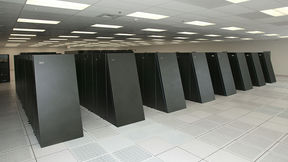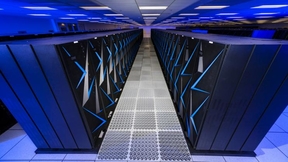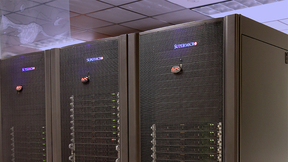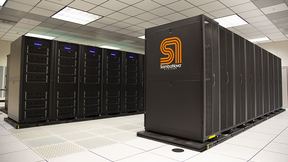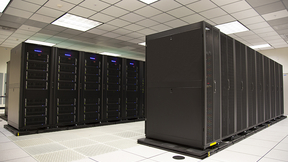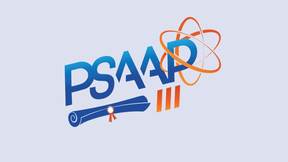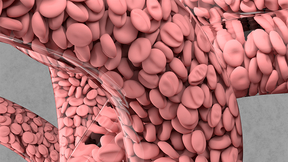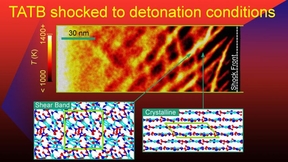Back
A team of current and former Lawrence Livermore National Laboratory (LLNL) and IBM scientists won the annual “Test of Time” award at the 2020 Supercomputing Conference on Nov. 19 for a paper outlining LLNL’s Blue Gene/L supercomputer. Published by the Supercomputing Conference in 2002, the paper was the first peer-reviewed overview article to disclose details of Blue Gene…
A machine learning model developed by a team of Lawrence Livermore National Laboratory (LLNL) scientists to aid in COVID-19 drug discovery efforts is a finalist for the Gordon Bell Special Prize for High Performance Computing-Based COVID-19 Research. Using Sierra, the world’s third fastest supercomputer, LLNL scientists created a more accurate and efficient generative…
Lawrence Livermore National Laboratory (LLNL) can lay claim to housing four of the world’s 100 most powerful supercomputers, more than any other institution according to the TOP500 List announced Monday during the virtual Supercomputing 2020 conference (SC20). The 125-petaFLOP peak Sierra, the National Nuclear Security Administration’s flagship supercomputer, remained…
Lawrence Livermore National Laboratory (LLNL), along with partners Intel, Supermicro and Cornelis Networks, have deployed “Ruby,” a high performance computing (HPC) cluster that will perform functions for the National Nuclear Security Administration (NNSA) and support the Laboratory’s COVID-19 research. Funded by NNSA’s Advanced Simulation and Computing (ASC) program, the…
Lawrence Livermore National Laboratory (LLNL) and its partners AMD, Supermicro and Cornelis Networks have installed a new high performance computing (HPC) cluster with memory and data storage capabilities optimized for data-intensive COVID-19 research and pandemic response. Funded by the Coronavirus Aid, Relief and Economic Security (CARES) Act, the “big memory” cluster,…
Lawrence Livermore National Laboratory (LLNL) has installed a state-of-the-art artificial intelligence (AI) accelerator from SambaNova Systems, the National Nuclear Security Administration (NNSA) announced today, allowing researchers to more effectively combine AI and machine learning (ML) with complex scientific workloads. LLNL has begun integrating the new AI hardware,…
With funding from the Coronavirus Aid, Relief and Economic Security (CARES) Act, Lawrence Livermore National Laboratory (LLNL), chipmaker AMD and information technology company Supermicro have upgraded the supercomputing cluster Corona, providing additional resources to scientists for COVID-19 drug discovery and vaccine research. The recent addition of nearly 1,000 AMD…
To solve a 100-year puzzle in metallurgy about why single crystals show staged hardening while others don’t, Lawrence Livermore National Laboratory (LLNL) scientists took it down to the atomistic level. The research appears in the Oct. 5 edition of Nature Materials. For millennia, humans have exploited the natural property of metals to become stronger or harden when…
Lawrence Livermore National Laboratory (LLNL) will provide significant computing resources to students and faculty from nine universities that were newly selected for participation in the National Nuclear Security Administration (NNSA)’s Predictive Science Academic Alliance Program (PSAAP). The program is funded by NNSA’s Office of Advanced Simulation and Computing (ASC)…
Lawrence Livermore National Laboratory (LLNL) and artificial intelligence (AI) computer company Cerebras Systems have integrated the world’s largest computer chip into the National Nuclear Security Administration’s (NNSA’s) Lassen system, upgrading the top-tier supercomputer with cutting-edge AI technology. Technicians recently completed connecting the Silicon Valley-based…
A Lawrence Livermore National Laboratory (LLNL) team has published new supercomputer simulations of a magnitude 7.0 earthquake on the Hayward Fault. This work represents the highest-ever resolution ground motion simulations from such an event on this scale. The study used the SW4 code developed at LLNL. Simulations resolved rapidly varying shaking with broader band…
One of the most common congenital heart defects, coarctation of the aorta (CoA) is a narrowing of the main artery transporting blood from the heart to the rest of the body. It affects more than 1,600 newborns each year in the United States, and can lead to health issues such as hypertension, premature coronary artery disease, aneurysms, stroke and cardiac failure. To…
Two Lawrence Livermore National Laboratory (LLNL) scientists have discovered a new mechanism for ignition of high explosives that explains the unusual detonation properties of 1,3,5-triamino-2,4,6-trinitrobenzene (TATB). The research will allow for systematic improvements to continuum mechanics models used to assess the performance and safety of the material accurately and…

